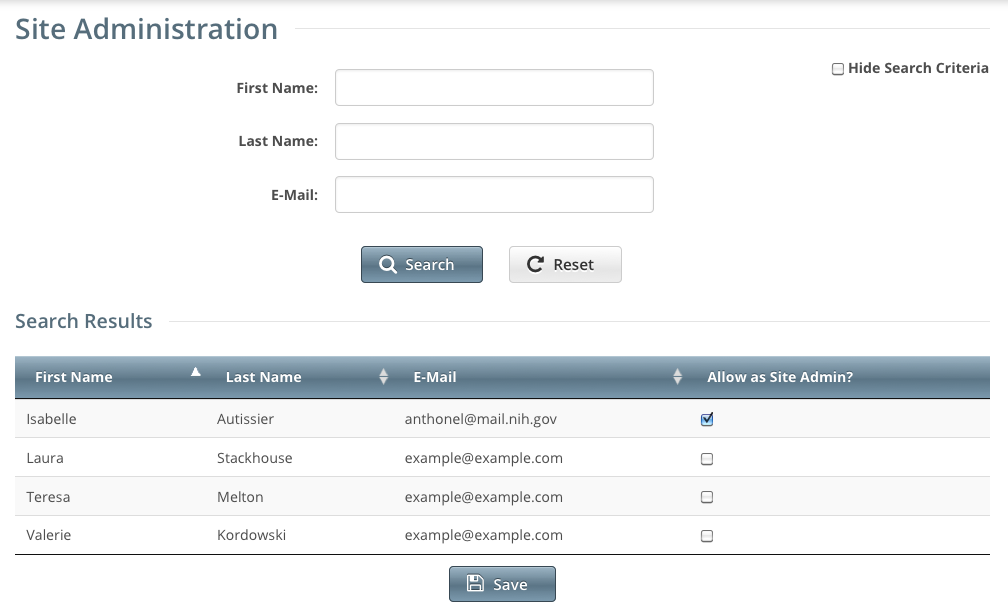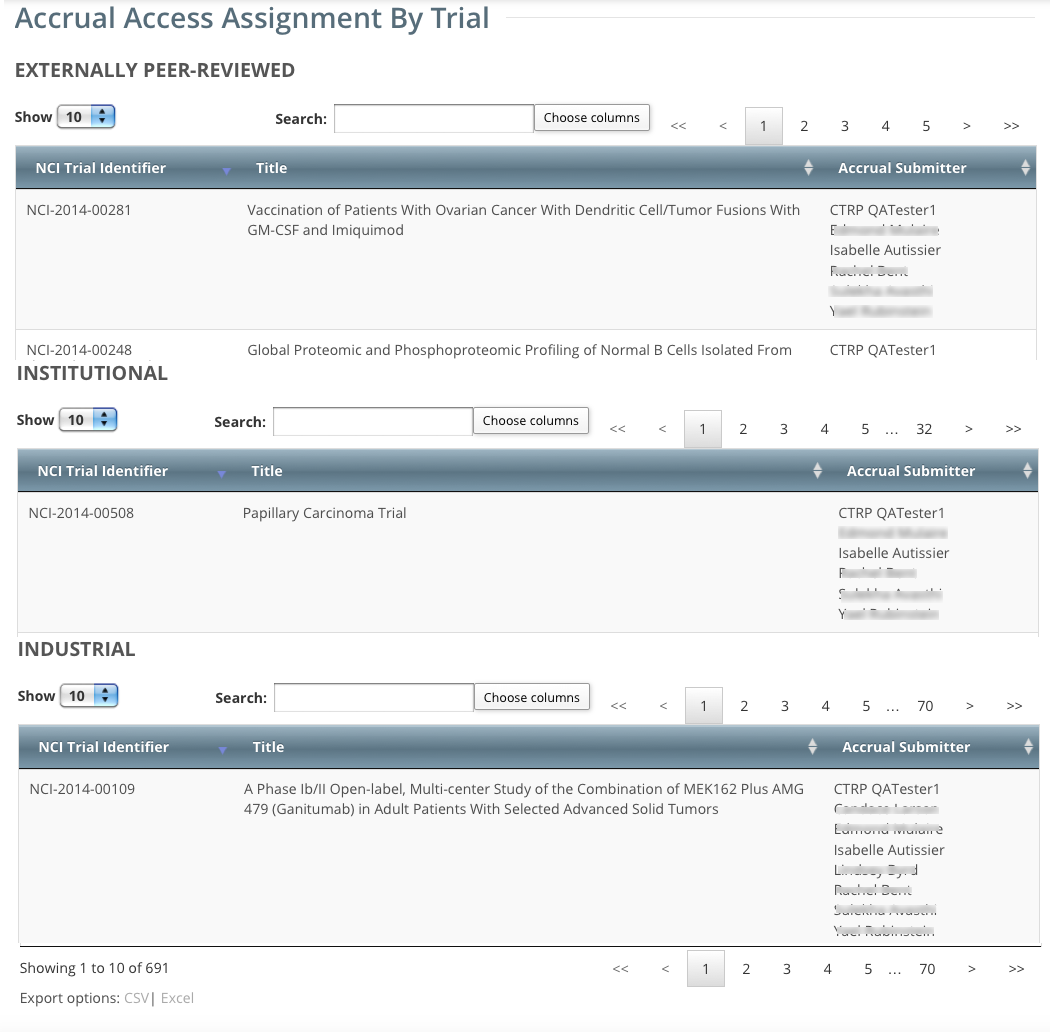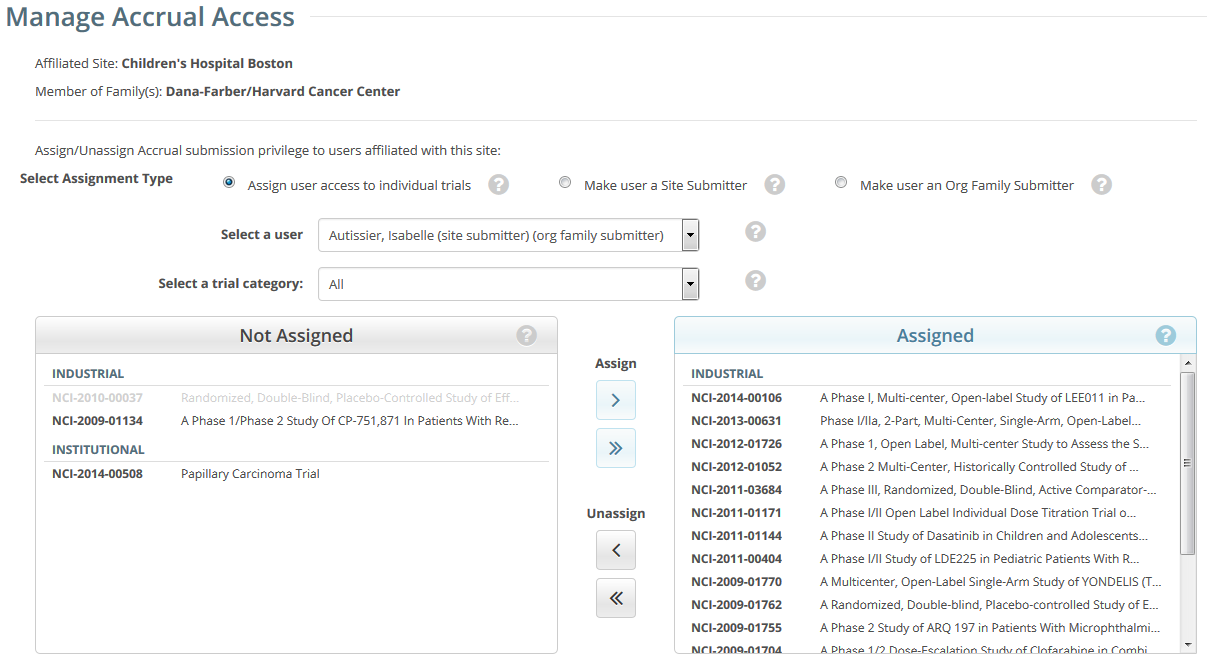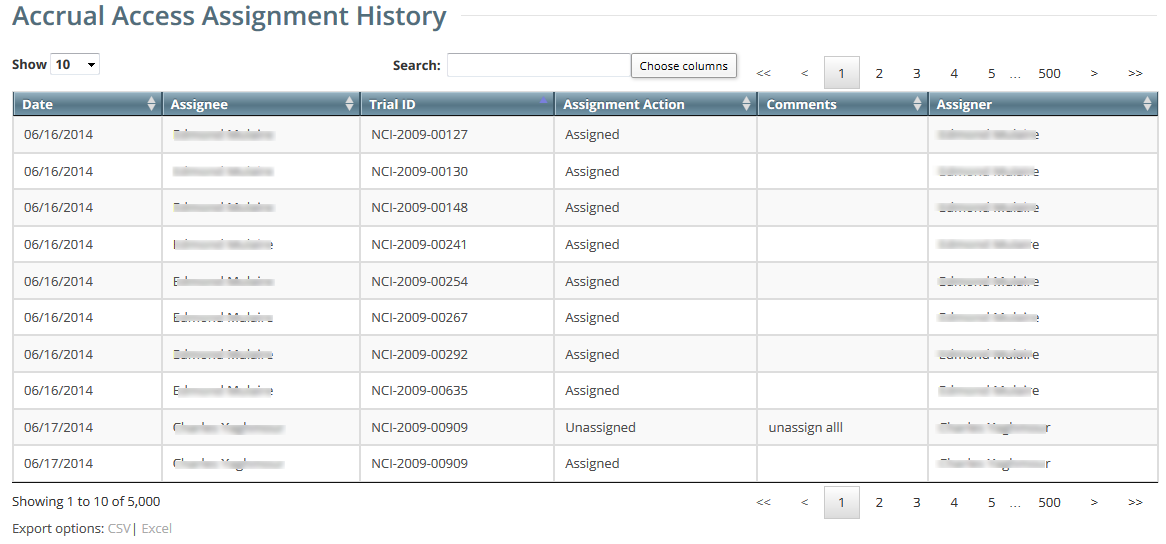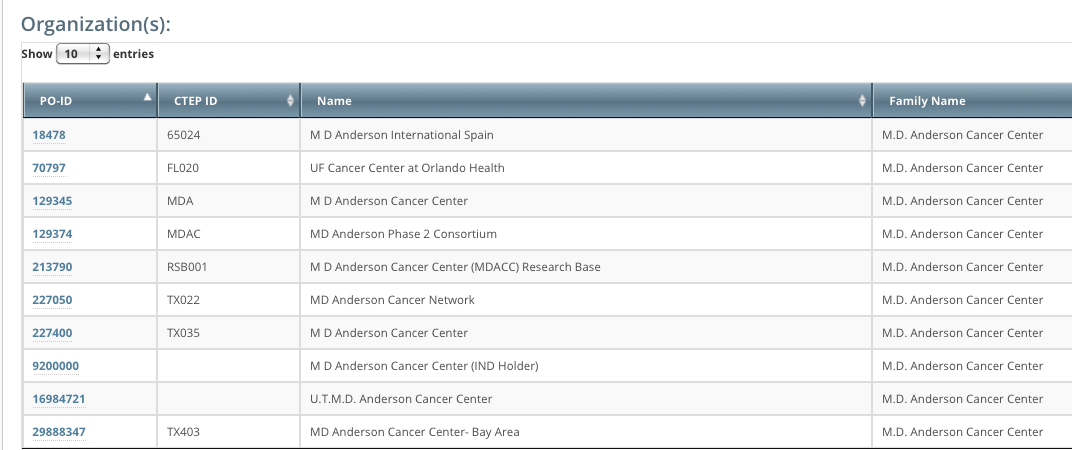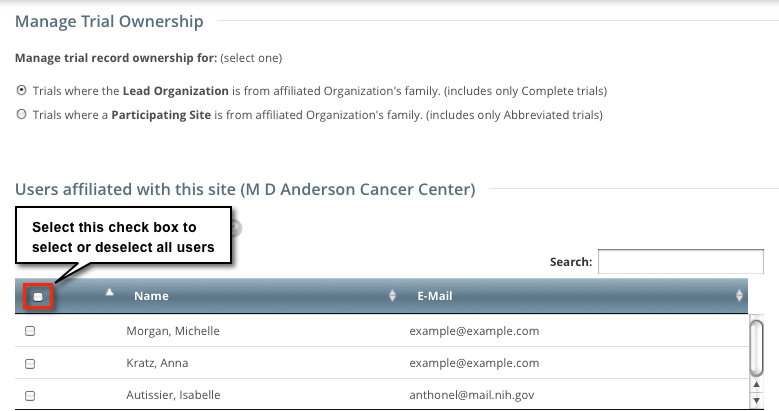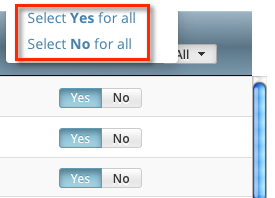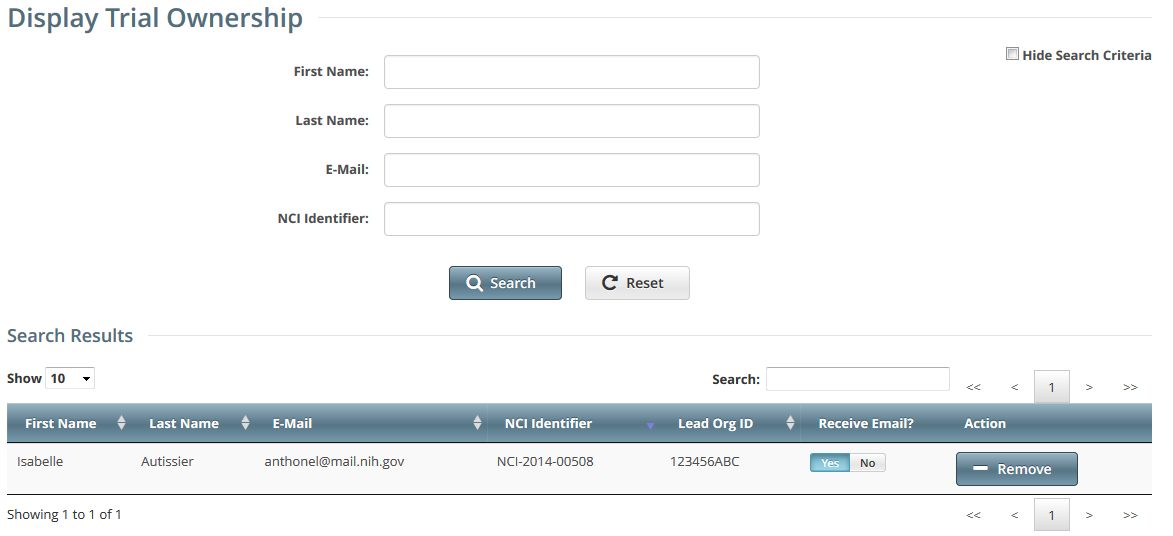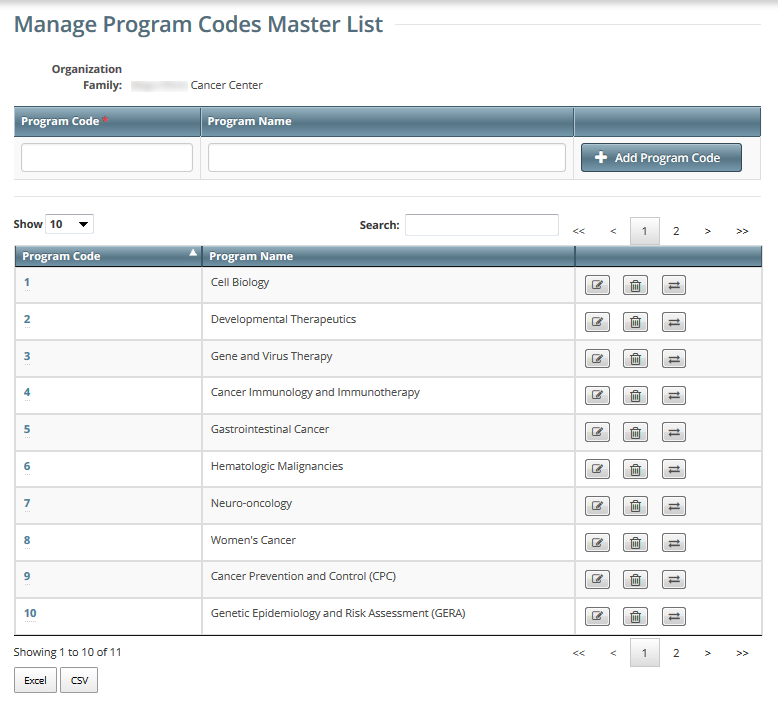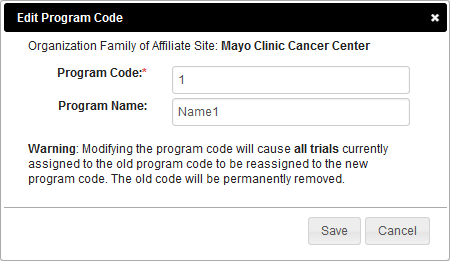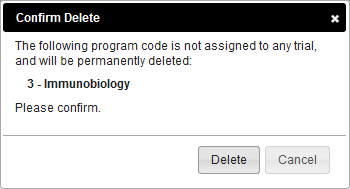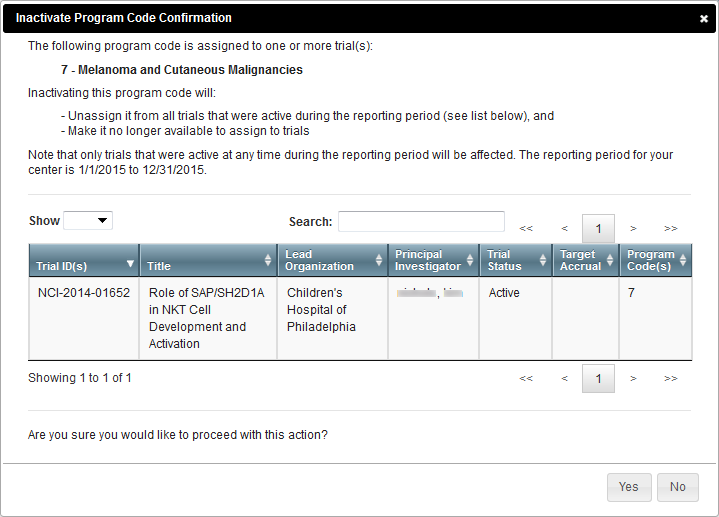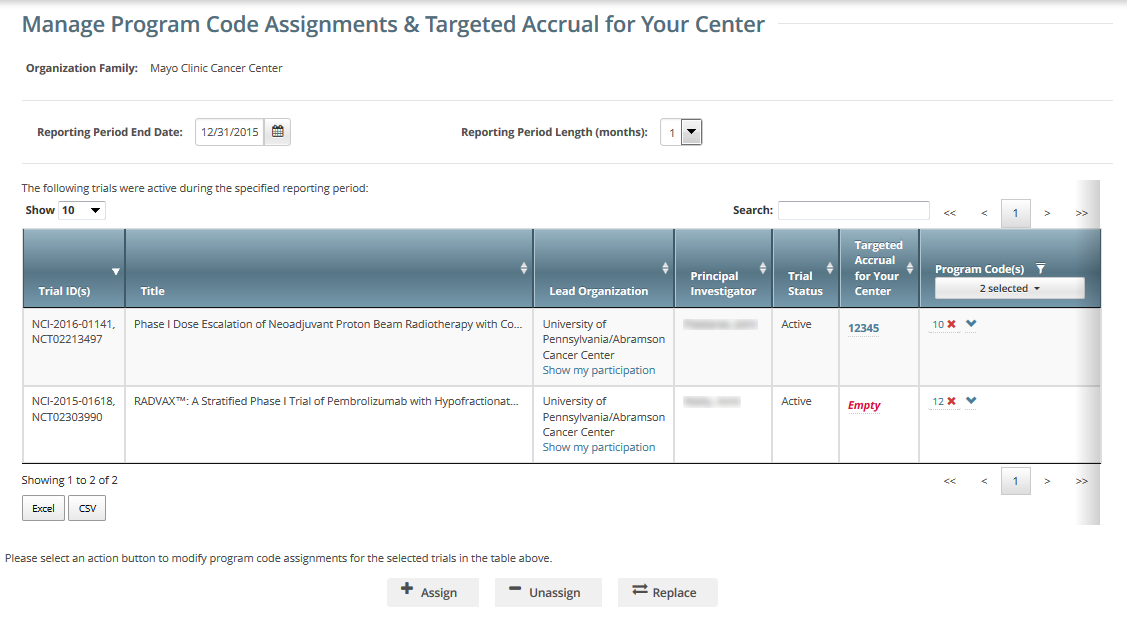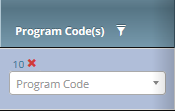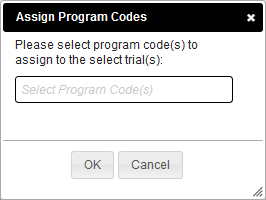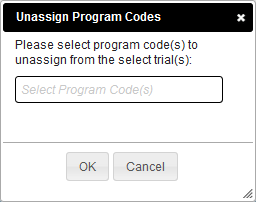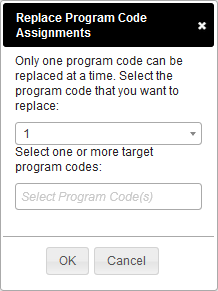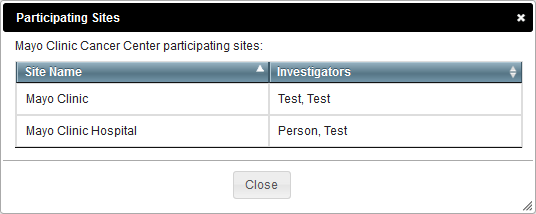This page provides instructions for site administrators. A site administrator is a user with administrative privileges who is responsible for reviewing and updating user access to trials owned by the organization, and for assigning site administrator status to other users in the organization. This page introduces you to site administration management and provides instructions for granting and revoking administrative authority.
About Site Administration
Granting and Revoking Administrative Authority
The relationships between administrators and trials in a single organization are as follows:
- An organization can have the following:
- One original site administrator
- Many site administrators appointed by the original administrator
- Many trials, providing that the organization plays the lead organization role
- Many users affiliated with the site who can submit and own trials
- A trial can have the following:
- One submitter
- One organization affiliation, defined by the lead organization
Many trial owners
Site administrators are trial owners by default if the site administrator's affiliated organization is the trial's lead organization. A site administrator can be added explicitly as an owner of any trial. Refer to Managing Trial Ownership .
- A site administrator can do the following:
- Display trial ownership
- Manage trial ownership
- Manage site record ownership
- Manage Accrual access
- Manage the administrative rights of other users in the organization
Revoke own administrative rights
Site administrators do not receive system-generated emails automatically
System-generated emails (including TSRs) are sent to a site administrator only if the site administrator's affiliated organization is the trial's lead organization, or if the site administrator is the trial submitter and/or trial owner. The site administrator can also manage email notification globally on the My Account page.
As a site site administrator, you can grant and revoke administrative rights to other users in your organization. (You can grant/revoke administrative authority to users who have a CTRP account and whose organizational affiliation is the same as your own.) Site administrators are the only Registration users who can see and access the Site Administration menu.
How to Grant and Revoke Site Administrator Rights
- On the toolbar, click Administration > Site Administration.
The Site Administration page appears, listing the administrators to whom administrator rights have previously been granted, if applicable.
- Search for the Registration user for whom you want to adjust administrative rights: specify the user by first name, last name, or email address, and then click Search. The user's name appears in the Search Results list.
To promote the user to site administrator, select the check box in the Allow as Site Admin? column.
As a site administrator you can revoke your own administrative rights. Use caution if you do so because you can not promote yourself thereafter.
To revoke administrative access, clear the check box under the Allow as Site Admin? column.
- Click Save.
Viewing Accrual Assignment History by Trial
As a site administrator, you can view a history of your organization's accrual access assignment on a per-trial basis.
How to View Accrual Assignment History by Trial
- On the toolbar, click Administration > Accrual Access > View.
The Accrual Access Assignment by Trial page lists all current access assignments by trial, grouped by trial category.
To navigate the table, refer to Working with Tables and Search Results .
Assigning and Unassigning Accrual Access
Site Administrators can authorize users to submit subject accrual data for trials that have been fully abstracted and verified. Once assigned, users can submit accrual data for all trials associated with their affiliated organization or organization family members. For Complete trials (National, Externally Peer-Reviewed, or Institutional), the organization must be a lead; for Abbreviated trials (Industrial), the organization must be a participating site.
Assignment at the organization level pertains to trials that the organization has registered in CTRP and extends to those that it will register in the future. Similarly, assignment at the organization family level pertains to trials that any member organization has registered in CTRP and extends to those that it will register in the future.
Access to CTEP and DCP trial accruals is restricted to the CTRO only.
The table below outlines the access and trial assignment rules for Complete and Abbreviated trials.
| Access/Assignment | Complete Trial | Abbreviated Trial |
|---|---|---|
| Who can assign access? |
|
|
| Who can be assigned access? | Any registered user affiliated with the Site Administrator's organization, or family member organization (including the Site Administrator) | Any registered user affiliated with the assigner's organization (including the site administrator) |
| What types of trials can be assigned? | Complete trials for which the assigner's organization is the lead organization | Abbreviated trials for which the assigner's organization is the Lead Organization or participating site |
| How is access assigned? |
The system automatically assigns the Organization Family Accrual Submitter access to any trial registered by new organizations added to an organization family in the future. It withdraws access if the Organization Family Accrual Submitter's organization is removed from the organization family in the future. |
|
| Who can submit accrual data? | Any assigned user, for any organization trials for which the assigner's organization is the Lead Organization | Any assigned user affiliated with the participating site |
| Which trials can the Organization Family Accrual Submitter submit accrual data to? |
|
|
___
Assigning and Unassigning Accrual Access by Trial
As a site administrator, you can assign a user Accrual access to any trial that the user submitted to the CTRP or currently owns.
How to Assign Accrual Access
- On the toolbar, click Administration > Accrual Access > Manage.
The Manage Accrual Access page appears.
- Select an assignment type.
- Select Assign user access to individual trials to assign specific trials to specific users. If you select this option, the Select a trial category list appears where you can narrow the list of trials to a category.
- Select Make user a Site Submitter to grant users rights to submit accruals for all trials in CTRP that have been submitted or will be submitted by the affiliated site.
- Select Make user an Org Family Submitter to grant users rights to submit accruals for all trials in CTRP that have been submitted or will be submitted by any site that is a member of the organization family.
From the Select a user list, select the user to whom you want to assign or unassign accrual submission privileges.
The list of trials available for accrual submission for the user you selected appears in the Not Assigned list on the left side of the page, and trials to which access had previously been granted (if any) appear on the right.To view the entire text of a trial's title, hover your cursor over the part of the title displayed.
Trials in the Not Assigned list that have not been validated appear in grey text and are unavailable for selection.
From the Not Assigned trial list, select the trial to which the user will submit accrual data, and then click the single arrow ( > ) under Assign. Or, to assign all eligible trials, click the double arrow ( >> ).
You can select multiple trials
To select multiple trials, click one trial, then press and hold the CTRL (or CMD) key and click one or more others. Then click the single arrow ( > ) under Assign.
A comment box appears.
Optionally, in the Comment box, enter a comment about this assignment, and then click Save.
Comments are optional. You can leave the comment field blank and still save it. To abort the assignment, click Cancel instead.
A message confirms your assignment. The assigned trial(s) appear in the Assigned list.
- To unassign access, from the Assigned trial list, select the trial you want to unassign, and then click the single arrow ( < ) under Unassign. Or, to unassign all trials, click the double arrow ( << ).
- Optionally, enter a comment in the Comments box, and then click Save.
The trial(s) you selected are moved to the Not Assigned list, and the user will no longer have access to them.
Assigning and Unassigning Accrual Access by Site
As a site administrator, you can assign a user Accrual access globally by site.
How to Assign Accrual Access by Site
- On the toolbar, click Administration > Accrual Access > Manage.
The Manage Accrual Access page appears. - Select Make user a Site Submitter.
Select the user from the Select a user drop-down list.
Click Assign/Unassign.
To unassign access, click Assign/Unassign again.
Assigning and Unassigning Accrual Access by Organization Family
As a site administrator, you can assign a user Accrual access globally by organization family.
How to Assign Accrual Access
- On the toolbar, click Administration > Accrual Access > Manage.
The Manage Accrual Access page appears. - Select Make user an Org Family Submitter.
Select the user from the Select a user drop-down list.
Click Assign/Unassign.
To unassign access, click Assign/Unassign again.
Viewing Accrual Assignment History
As a site administrator, you can view a history of your organization's trials to which users have been assigned/unassigned user access.
How to View Accrual Assignment History
- On the toolbar, click Administration > Accrual Access > Assignment History.
The Accrual Assignment History page lists all access assignments and assignments.
- To navigate the table, refer to Working with Tables and Search Results .
- To export the assignment history to a file, click CSV (comma-separated values) or Excel in the bottom left corner.
Your browser prompts you to open or save the file.
Managing Trial Ownership
Trials are associated with the user who last submitted the trial, and with the last submitter's affiliated organization.
For example, in the figure below, Isabelle Autissier (username = CTRPDOC1) submitted the trial while affiliated with M D Anderson. She is the Last Submitter, and trial owner. And M D Anderson is the last Submitter Organization and trial owner.
The CTRP system identifies the trial by the Last Submitter and the last Submitter Organization. In the figure below, username CTRPDOC1 is affiliated with M D Anderson as per the account information in the figure above.
If Isabelle Autissier changes her organization affiliation to another within the organization family such as U.T. M.D Anderson Cancer Center after having submitted the trial, both she and her original organization retain trial ownership.
However, if Isabelle Autissier changes her organization affiliation to an organization outside the organization family such as Vanderbilt-Ingram Cancer Center, she loses trial ownership of all trials affiliated with M D Anderson. Her trial will not be among the "Search My Trials" results. M D Anderson Cancer Center retains trial ownership; Vanderbilt-Ingram Cancer Center does not assume trial ownership despite the Last Submitter's new organization affiliation.
The example above is based on Complete trials. The same principals apply to Industrial trials but site record ownership rather than trial ownership is affected by affiliate changes.
Assigning Trial Ownership
As a Site Administrator, you can assign and unassign trial ownership rights to multiple users in your affiliated organization and its family member organizations, and multiple trials at the same time. (Trials displayed on the Manage Trial Ownership page are those that you have submitted or those submitted by users if the trial's lead organization is the same as your affiliated organization or its family member organizations.)
For example, you can grant ownership of one trial to three CTRP users within your organization. Or, you can grant one user ownership of three trials.
Additionally, you can indicate which of the owners you assign will receive notifications about the trial(s) via email.
For Abbreviated trials, owners are responsible for updating their affiliated organization's information on trials in which their site is a participant, using the Update My Site action. Owners can update the following information:
- Organization family's program code
- Organization's local trial identifier
- Site principal investigator
- Site recruitment status and dates
Trial ownership requirements
You may not be able to change trial ownership using the Manage Trial Ownership functionality in certain circumstances. For example, you may not be able to change trial ownership if the trial status is Complete rather than Active, and the lead organization is not the trial submitter's affiliated organization. (Refer to Recording Site Recruitment Statuses and Dates .) However, you can request trial ownership changes by contacting the CTRO. When requesting trial ownership changes, include the new owner's first name, last name, and email address. Ensure that the user has registered in CTRP or has a valid CTRO account.
Your affiliated organization is stored with your account information on the My Account page. Your affiliation determines which trials and which users you can assign.
You can assign any trial submitted by your affiliated organization or it family member organizations. For example, if you are affiliated with the M D Anderson Cancer Center, you can manage trial assignments for trials that M D Anderson International and UF Cancer Center at Orlando Health own.
The organization must be a lead organization for Complete trials, or a participating site for Abbreviated trials.
___
How to Assign and Unassign Trial Ownership
On the toolbar, click Administration > Trial Ownership > Manage.
The Manage Trial Ownership page displays the names of your affiliated organization or it's family member organization(s) users on the top of the page, and trials that your organization owns as a Lead Organization or Participating Site below the list of names.
- Under Manage trial ownership for, select which role your affiliated organization or its family member organization(s) play(s).
- For Complete trials, select Lead Organization.
- For Abbreviated trials, select Participating Site.
To indicate which users will have the ability to update and amend selected Complete trials; or update Abbreviated trials, select one or more user names on the list.
You can select or deselect all names, or filter the list of names
To select all names, select the check box on the left side of the column heading. Click it again to deselect all names.
To filter the list of names, in the Search field, type one or more characters contained in a user's name or email address. The list is filtered as you type subsequent characters.
In the list of trials at the bottom of the page, under All Available Trials, or All Abbreviated Trials, select the trials to assign to the user(s), and then click the Assign icon ( > ).
To unassign trials, under Trial Ownership Assignments, or Site Owner Assignments, select the user(s) you want to unassign, and click the Unassign icon (<).
For Complete trials, indicate which trial owners should receive email notifications about the trial(s):
In the Email Notifications? column, click the Yes or No button.
To indicate that all owners should receive/not receive email, in the Email Notification column header, click All > Select Yes/No for all.
The Select No for All and Select Yes for All options apply globally to all trial owners, not just the ones currently visible in the list.
Displaying Trial Ownership
As a site administrator, you can display trial ownership for any trial owned by your site for which your organization or its family member organization is the lead organization. Trial owners can view trial details, update trials, and amend Complete trials. Additionally, you can indicate whether a user would like to receive system notifications, including TSRs and XML files, on a trial-by-trial basis.
TSR and XML distribution
Trial owners can access TSR and XML documents.
How to Display Trial Ownership
- On the toolbar, click Administration > Trial Ownership > View.
The Display Trial Ownership page displays the current owner(s) of the trials for which your organization is the lead organization. It also indicates which of the owners, for each of the trials, will receive system-generated email notifications.
- To display all the trials owned by a given user, search for the user by first name, last name, or email address, and then click Search.
All trials owned by the user are listed in the Search Results list. To display all owners of a given trial, enter the NCI Identifier in the field provided, and then click Search.
All owners of the selected trial are listed in the Search Results list.You can filter the search results and create more space to display the results
To filter the search results, in the Search field, type one or more characters contained in any of the fields. The list is filtered as you type subsequent characters. For details, refer to Working with Tables and Search Results .
To create more space on the page, on the upper right corner of the page, select the Hide Search Criteria check box.
To indicate whether or not an owner of a trial should receive system-generated email messages, in the Receive Email? column, select Yes or No.
Selecting Yes indicates that the owner will receive all notifications regarding the specified trial.
Selecting No indicates that the owner will not receive any notifications regarding the specified trial.
- To revoke ownership of a trial, locate the user/trial in the Search Results list, and then click Remove.
Adding Sites
Managing Program Codes
Each cancer center family uses program codes to group its clinical trials. As a site administrator, you can manage the set of program codes and program code assignments for your organization family. You can assign program codes to trials that meet all of the following criteria:
Viewing Program Codes
Notice that this page displays information specific to your organization family. You can navigate through the list of program codes just like any other list of search results in the CTRP Registration application. For instructions, refer to Working with Tables and Search Results.
Adding Program Codes
For each organization family, active program codes must be unique. The list may contain two entries with the same program code, if one is active and the other is inactive.
Editing Program Codes
When you change a program code, the system re-assigns to the new program code all trials (including closed trials) currently assigned to the old program code.
Deleting or Inactivating Program Codes
- On the Manage Program Codes Master List page, in the row for the program code of interest, click the Delete icon (). The system checks whether the selected program code has been assigned to any trials. What happens next depends on the result of that system check:
- If the selected program code has not been assigned to any trials, then a message appears, asking you to confirm the deletion.
- Otherwise, a dialog box appears with details, asking you to confirm the inactivation.
- If the selected program code has not been assigned to any trials, then a message appears, asking you to confirm the deletion.
- After reading the provided information, confirm or cancel the action:
- To confirm deletion, click Delete. To confirm inactivation, click Yes. The list changes to reflect your action:
- If you deleted a program code, the system removes the program code completely.
- If you inactivated a program code, the system removes the program code from only trials that were active at any time during the reporting period. The program code remains in the Master List with “-inactive” appended, but you can no longer assign it to trials.
- To cancel deletion, click Cancel. To cancel inactivation, click No.
- To confirm deletion, click Delete. To confirm inactivation, click Yes. The list changes to reflect your action:
Viewing the Assignments for a Program Code
In Review Approved Active Enrolling by Invitation Temporarily Closed to Accrual Temporarily Closed to Accrual and Interventions You can navigate through the list of trials just like any other list of search results in the CTRP Registration application. For instructions, refer to Working with Tables and Search Results. On the Program Code Assignments page, in the search box, if you include the search term in double quote marks (for example "cancer"), the search results include trials that have an exact match in any of the first five columns.
Assigning a Program Code to a Single Trial
You can also assign a program code to a trial while performing the following tasks:
The Program Code field appears.
Unassigning a Program Code from a Single Trial
On the Manage Program Code Assignments page, in the row for the trial of interest, in the Program Code(s) column, click the x for the program code you want to unassign. The Program Code(s) column reflects your changes. You can also unassign a program code to a trial while performing the following tasks:
Assigning Program Codes to Multiple Trials
- On the Manage Program Code Assignments page, select one or more trials of interest.
- Click Assign. The Assign Program Codes dialog box appears. The list includes all program codes that can be assigned to the selected trials.
- In the list, select one or more target program codes.
- Click Assign. On the Manage Program Code Assignments page, the Program Code(s) column reflects your changes.
Unassigning Program Codes from Multiple Trials
- On the Manage Program Code Assignments page, select one or more trials that have been assigned to program codes.
- Click Unassign. The Unassign Program Codes dialog box appears with a list of all program codes, but only the ones assigned to the selected trials are available for selection.
- In the list, select one or more program codes.
- Click Unassign. On the Manage Program Code Assignments page, the Program Code(s) column reflects your changes.
Replacing a Program Code
- On the Manage Program Code Assignments page, select one or more trials that have been assigned to program codes.
- Click Replace. The Replace Program Code Assignments dialog box appears with two lists. The first list includes all program codes assigned to any selected trial.
- In the first list, select the program code that you want to replace.
The second list includes all program codes for the organization family. However, the one you selected in the first list becomes unavailable for selection in the second list. - In the second list, select one or more target program codes.
- Click Replace. On the Manage Program Code Assignments page, the Program Code(s) column reflects your changes.
Viewing Your Participation
- On the Manage Program Code Assignments page, in the row for the trial of interest, in the Lead Organization column, click Show my participation. The Participating Sites dialog box appears, listing only the participating organizations that are members of your organization family.
- When you are done viewing the list of participating sites, click Close.

